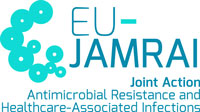Step by step guide for the implementation and assessment of VR-based Simulations
- Virtual Reality (VR): Creates fully immersive, computer-generated three-dimensional (3D) environments that users can explore and interact with, typically using headsets that block out external stimuli. VR allows for the simulation of complex or hazardous real-life AMR/AMS scenarios (e.g., managing an outbreak, performing aseptic techniques in a contaminated environment) in a safe, controlled setting. (Fertleman et al., 2018; Akhtar et al., 2024).
- Augmented Reality (AR): Overlays digital information, such as 3D models, text, or animations, onto the user’s real-world view, typically via smartphones, tablets, or specialized AR glasses. In AMR/AMS, AR could be used to visualize microbial contamination on surfaces, provide real-time procedural guidance for infection prevention, or display context-specific AMS information. (Akhtar et al., 2024).
- Expanded Reality (ER or XR): An umbrella term encompassing VR, AR, and Mixed Reality (MR – which blends real and virtual worlds to produce new environments and visualizations where physical and digital objects co-exist and interact in real time). XR technologies offer a spectrum of immersive and interactive experiences for education and training. (Gasteiger et al., 2022, use XR as an umbrella term). These technologies aim to enhance learning by providing experiential, engaging, and safe practice opportunities, leading to better knowledge retention, skill acquisition, and decision-making capabilities in the context of AMR/AMS. (Gasteiger et al., 2022, highlight XR’s ability to trigger realism, deep immersion, and enable interactive learning)

Planning a VR-based Simulations
The following steps should be taken into consideration when planning a VR/AR/ER experience on AMR/AMS:
- Needs Assessment and Learning Objective Definition: Identify specific AMR/AMS training needs where XR’s unique capabilities (e.g., immersion, visualization of unseen processes, safe practice of high-risk procedures, understanding complex system dynamics) offer significant advantages over traditional methods. Clearly define measurable learning objectives.
- Technology and Platform Selection: Choose the most appropriate XR technology (VR for full immersion in simulated environments; AR for contextual information overlay; MR for interactive blending) and development platforms/tools. Consider factors like learning objectives, target audience technical literacy, available resources, and potential for scalability, including exploring lower-cost AR options for resource-constrained settings. (Akhtar et al., 2024).
- Scenario Design and Content Development: Create realistic, engaging, and pedagogically sound AMR/AMS scenarios. This involves developing accurate 3D models, interactive elements, clear user pathways, and feedback mechanisms. Storytelling, emotional engagement, and challenging decision-points can be powerful components, particularly in VR. (Fertleman et al., 2018, discuss creating empathy and understanding patient perspectives through VR).
- Software Development and Hardware Procurement: Develop the XR application, which may involve collaboration with specialized developers. Procure and set up necessary hardware (e.g., VR headsets, AR-compatible smartphones/tablets, motion controllers) and ensure a suitable physical space for use if required (especially for VR).
- Pilot Testing and Iterative Refinement: Conduct thorough pilot testing with representatives of the target audience to assess usability, technical functionality, realism, engagement, and the perceived achievement of learning objectives. Use feedback for iterative design improvements.
- Integration into Training and Facilitation Strategy: Integrate the XR simulation into a broader AMR/AMS training curriculum or program. This includes providing clear instructions on using the technology, orienting users to the simulation’s goals, and, critically, planning for effective facilitation and structured debriefing post-simulation. (Fertleman et al., 2018, emphasize that VR is a tool and its effectiveness depends on how it is built into the curriculum, including the debrief).

Defining roles in a VR-based Simulations
Facilitator’s role: Introduce the simulation, its learning objectives, and how to use the technology safely and effectively. Monitor participants during the simulation, providing technical assistance as needed. Most importantly, lead structured, reflective debriefing sessions after the XR experience to help participants process their actions, decisions, and emotions; discuss consequences observed in the simulation; connect these experiences to real-world AMR/AMS principles and practices; and identify key learning points.
Participant’s role (App user): Actively engage with the immersive or augmented environment, follow instructions, interact with simulated elements as required by the scenario, make decisions based on their understanding of AMR/AMS principles, experience the consequences of those decisions in a safe and controlled space, and participate openly and reflectively in debriefing sessions to consolidate learning and consider application to their professional context.

Assessing a VR-based Simulations
Methods
- In-simulation Performance Metrics: Tracking and analyzing user actions, decision-making pathways, accuracy of procedural steps, adherence to simulated AMR/AMS protocols (e.g., correct hand hygiene technique in VR, appropriate selection of PPE), time to task completion, and errors made within the simulation.
- Pre- and Post-Simulation Assessments: Measuring changes in knowledge, skills (e.g., using objective structured clinical examinations (OSCEs) if the XR simulation targets procedural skills), attitudes, empathy, or decision-making capabilities related to AMR/AMS. (Fertleman et al., 2018, suggest VR’s potential for empathy training).
- Behavioral Observation: Observing participants’ behaviors and problem-solving approaches during the simulation (if feasible via screen sharing or observation modes) and their contributions during debriefing sessions.
- Participant Feedback: Collecting feedback on the realism of the simulation, level of immersion and engagement, ease of use of the technology, perceived learning value, and satisfaction with the experience. (Gasteiger et al., 2022, note improved learner satisfaction as an outcome of XR training).
Tools
Simulation analytics platforms (if available for tracking in-simulation data), performance checklists or rubrics for specific tasks, validated knowledge and attitude questionnaires, OSCE stations or standardized skill assessment tools, user experience surveys incorporating scales for presence, immersion, and usability (e.g., System Usability Scale – SUS).

Suggested VR-based Simulations prototype
Target Audience: Legislators and Authorities, Wastewater Managers, Health Managers, Prescribers (human and veterinary), Researchers, and Educators.
Learning Objectives:
- Enhance understanding of the interconnectedness of human, animal, and environmental factors in the emergence and spread of a novel AMR threat.
- Develop skills in intersectoral communication and collaborative decision-making during a simulated AMR outbreak.
- Allow participants to explore the potential impacts of different policy and intervention strategies (e.g., restrictions on antibiotic use in agriculture, enhanced hospital IPC, wastewater treatment upgrades) on controlling the AMR outbreak within a simulated system.
- Foster a deeper appreciation for the complexities and trade-offs involved in formulating One Health AMR policies.
Curriculum/Activities:
- Participants (individually or in small interprofessional teams) enter a VR environment depicting a region experiencing an emerging AMR crisis (e.g., a new resistant bacterium affecting both livestock and humans, with suspected environmental contamination pathways).
- Interactive Exploration: Users can “visit” different locations (e.g., a farm, a hospital, a veterinary clinic, a wastewater treatment plant, a policy briefing room) to gather data, interview virtual stakeholders, and observe the consequences of the AMR outbreak.
- Decision-Making Points: At critical junctures, users are presented with policy or intervention choices relevant to their assigned role or as a collective team (e.g., “Implement stricter antibiotic use regulations for livestock?” “Invest in advanced wastewater treatment?” “Launch a public health campaign?”).
- Simulated Consequences: The VR environment dynamically visualizes the short-term and potential long-term consequences of their decisions on AMR spread, public health outcomes, economic impact, and environmental contamination levels within the simulation. (Akhtar et al., 2024, highlight VR for visualizing complex systems).
- Debriefing: After the VR experience, a facilitated debriefing session allows participants to discuss their choices, the challenges of intersectoral collaboration, the effectiveness of different interventions, and the ethical considerations involved in managing AMR from a One Health perspective.
Evaluation of the Prototype’s Effectiveness:
- Pre- and post-simulation surveys assessing understanding of One Health principles, complex AMR system dynamics, and intersectoral policy considerations.
- Analysis of decisions made within the simulation and the rationale discussed during debriefing sessions.
- Qualitative feedback from participants on the realism, engagement, and impact of the VR experience on their understanding of AMR policy challenges and the importance of a One Health approach.
- Assessment of changes in participants’ perspectives on intersectoral collaboration for AMR, or their ability to articulate complex AMR issues to diverse audiences.
References
- Akhtar, M. H., Anderson, M., & Cochrane, T. (2024). Implementing Augmented Reality and Virtual Reality for authentic healt hcare education. Pacific Journal of Technology Enhanced Learning, 6(1), 2–3. https://doi.org/10.24135/pjtel.v6i1.177
- Fertleman, C., Aubugeau-Williams, P., Sher, C., Lim, A.-N., Lumley, S., Delacroix, S., & Pan, X. (2018). A Discussion of Virtual Reality As a New Tool for Training Healthcare Professionals. Frontiers in Public Health, 6. https://doi.org/10.3389/fpubh.2018.00044
- Gasteiger, N., van der Veer, S. N., Wilson, P., & Dowding, D. (2022). Exploring How, for Whom and in Which Contexts Extended Reality Trainin g “Works” in Upskilling Healthcare Workers: A Realist Review. 2022 IEEE Conference on Virtual Reality and 3D User Interfaces Abstrac Ts and Workshops (VRW), 734–735. https://doi.org/10.1109/vrw55335.2022.00218
- Rocha-Pereira, N., Castro Sanchez, E., & Nathwani, D. (2017). How Can Multi-Professional Education Support Better Stewardship? Infectious Disease Reports, 9(1), 6917. https://doi.org/10.4081/idr.2017.6917
- Rocha-Pereira, N., Lafferty, N., & Nathwani, D. (2015). Educating healthcare professionals in antimicrobial stewardship: Can online-learning solutions help? Journal of Antimicrobial Chemotherapy, 70(12), 3175–3177. https://doi.org/10.1093/jac/dkv336
- Rogers Van Katwyk, S., Jones, S. L., & Hoffman, S. J. (2018). Mapping educational opportunities for healthcare workers on antimicrobial resistance and stewardship around the world. Human Resources for Health, 16(9). https://doi.org/10.1186/s12960-018-0270-3
